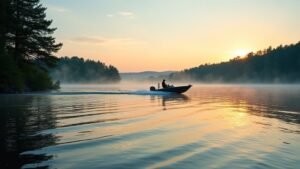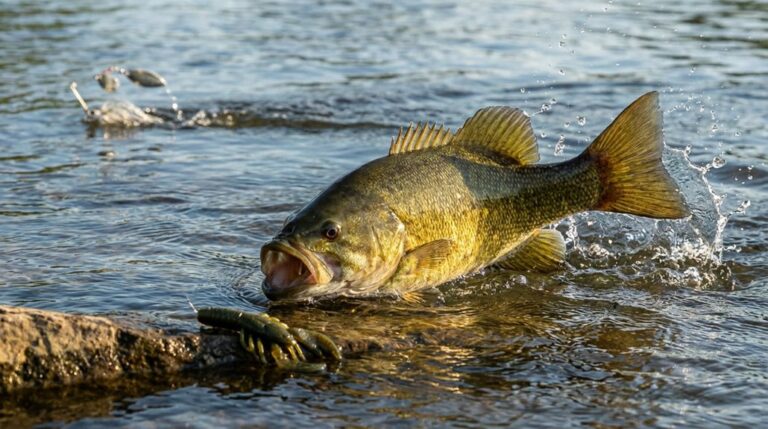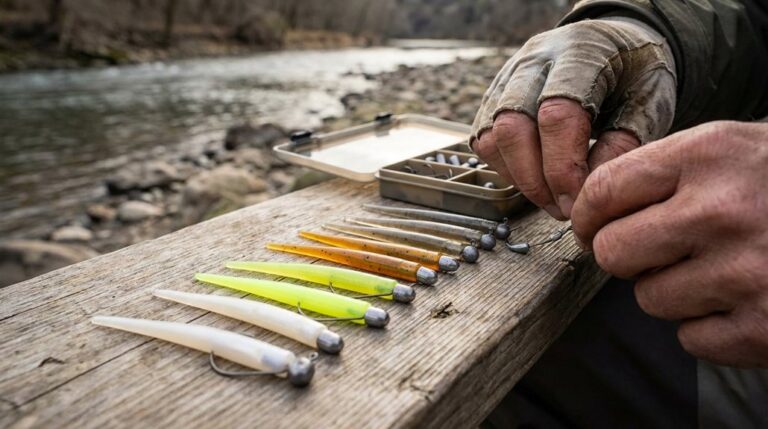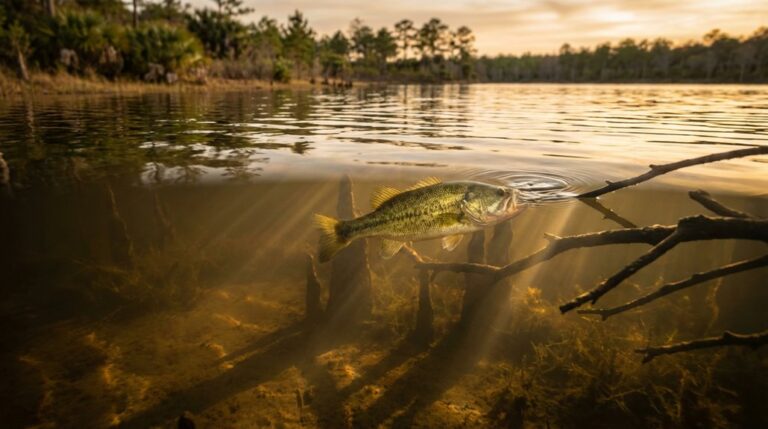If you’re chasing big bass in New England, head to Lake Champlain for both largemouth and smallmouth action, Sebago Lake in Maine for feisty smallmouth, and Quabbin Reservoir for weedbed largemouth fishing. Try Candlewood and Winnipesaukee for structure-rich ambush zones, Bantam for summer smallmouth, and Memphremagog for cross‑border opportunities. Each lake offers distinct structure, clear water, and season-specific tactics, and you’ll find tips and local hotspots if you want more detail.
Important Takeaways
- Lake Champlain offers prolific largemouth and smallmouth fishing across 120 miles of varied shoreline and tournament-grade action.
- Sebago Lake is a smallmouth powerhouse with clear water, rocky points, weed edges, and year-round angling.
- Quabbin Reservoir produces aggressive largemouth in shallow bays, weedbeds, and submerged timber for boat and shore anglers.
- Candlewood Lake provides structure-rich bass fishing around coves, rocky points, canals, and weed edges year-round.
- Lake Winnipesaukee, Bantam Lake, and Memphremagog feature big bass, rocky shallows, and cross-border opportunities with additional trout and salmon.
Lake Champlain — Largemouth and Smallmouth Hotspots
Why does Lake Champlain keep drawing bass anglers? You’ll find Champlain Lake offers both largemouth bass and smallmouth bass across 120 miles of shoreline, hard-bottom habitat and varied structure that concentrates fish. On early-season outings you’ll target pre-spawn staging along shallow, structure-rich shorelines where bass fishing heats up. Tournament anglers know this: Champlain fishing tournaments have produced huge weights and big bass, including Elite Series totals that proved the lake’s potential.
You’ll appreciate the multi-state fishing access between Vermont, New York and Quebec, plus consistent post-spawn action that keeps trips productive. With abundant fish, proven tournament performance and easily read shorelines, Lake Champlain still ranks high on any New England angler’s list. Ice retention on coolers like the Grizzly 60 can help keep your catch fresh on long outings, especially those lasting several days with exceptional insulation.
Sebago Lake — Smallmouth Powerhouse in Maine
If Lake Champlain pulls anglers with its mixed largemouth and smallmouth action, Sebago Lake in Maine will grab you for one reason: smallmouth. You’ll find clear waters and varied underwater habitat that create ideal structure for aggressive smallmouth bass. It’s a multi-species lake, so year-round fishing brings lake trout and landlocked salmon alongside bass, expanding angling opportunities.
- Strong smallmouth bass population that fights hard
- Clear waters revealing rocky points, weed edges, and drop-offs
- Underwater habitat complexity concentrates fish around structure
- Year-round fishing appeal with seasonal tactics to match
- Multi-species lake enhances trips with additional targets
You’ll enjoy focused bass fishing without sacrificing variety or scenery. Smallmouth often prefer rocky points and clear, cooler water where structure concentrates prey.
Quabbin Reservoir — Productive Largemouth Water
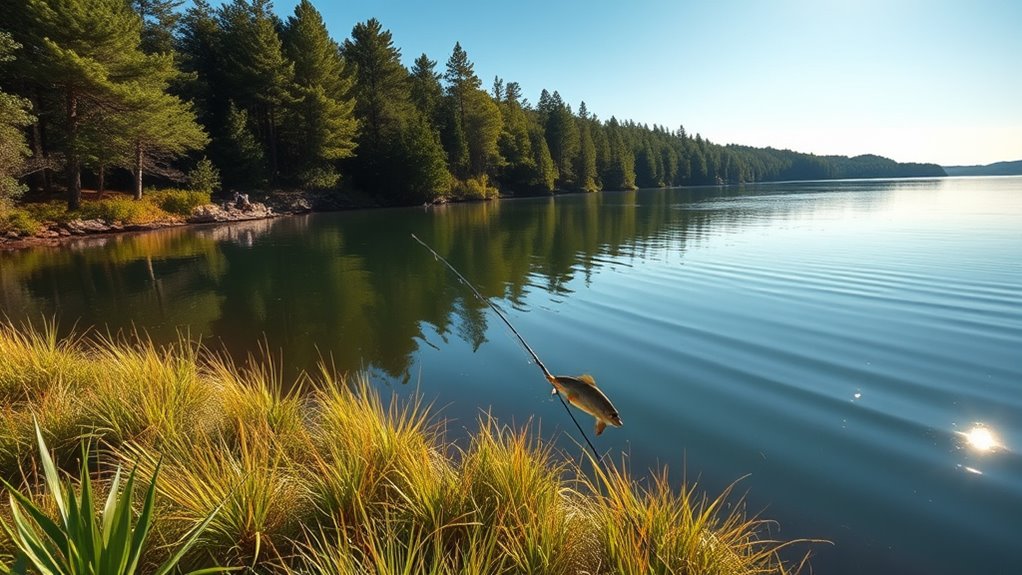
Quabbin Reservoir is Massachusetts’ largest inland water and a dependable spot for largemouth anglers, with shallow bays, submerged timber, and extensive weedbeds that concentrate aggressive bass and make targeted presentations effective. When you fish Quabbin Reservoir, focus on the largemouth bass that thrive in those submerged habitats and shallow waters; bass-specific tactics like weedless topwaters, jig-and-punch, and soft plastics around timber pay off. This freshwater fishing destination ranks among New England lakes for productive reservoir fishing and accessible shore and boat opportunities. You’ll find trout and salmon present, but tailoring gear and retrieves to bass will raise your catch rate. Combine a day of Massachusetts fishing with hiking or camping for a full outdoor trip. Offshore structures like artificial reefs created by converted oil rigs can similarly concentrate fish and offer productive tactics for anglers seeking big-game action.
Candlewood Lake — Connecticut Bass and Structure Fishing
Candlewood Lake offers Connecticut anglers clear water and a mix of rocky points, weed edges, and deeper canals that concentrate both smallmouth and largemouth bass year-round. You’ll find structure fishing pays off here as the reservoir’s coves and rocky shoreline create ambush zones for active bass. Targeting both largemouth bass and smallmouth bass, you’ll switch between soft plastics, jigs, and faster presentations like spinnerbaits to trigger reaction strikes. The lake’s canal-style areas and extensive weed edges remain productive through seasons, so plan for varied retrieves and depth changes.
- Focus on coves with rocky shoreline for feeding fish
- Fish weed edges with soft plastics and jigs
- Use spinnerbaits around points and shallow flats
- Try canals for mid-depth smallmouth concentrations
- Vary retrieve speed to match forage behavior
Water temperature and oxygen levels often influence bass location, so check for oxygen-rich riffles near shallow structure before choosing presentations.
Lake Winnipesaukee — New Hampshire Smallmouth and Largemouth
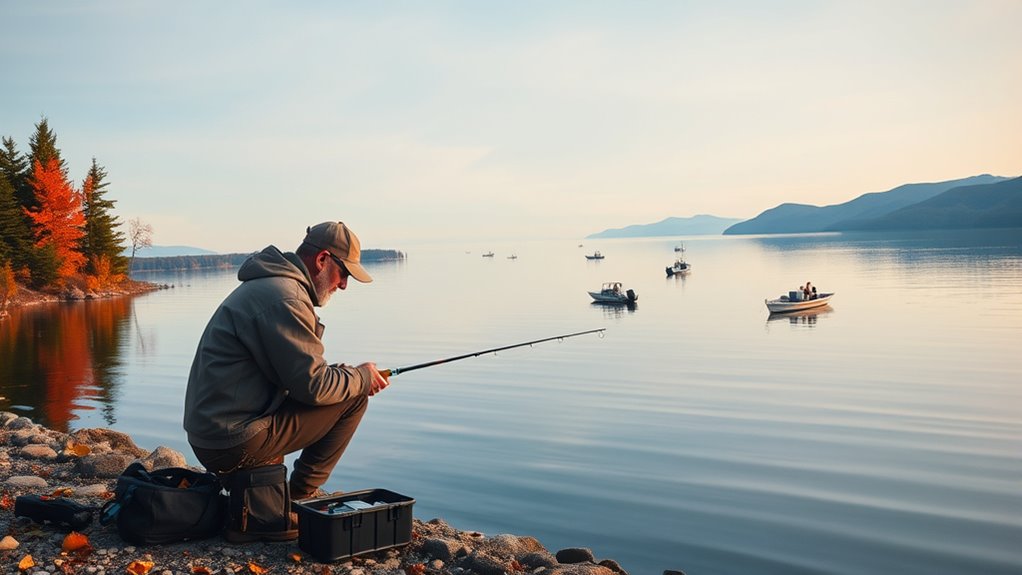
Looking for big bass in New England? Lake Winnipesaukee in New Hampshire is a top choice for bass fishing, offering both smallmouth bass and largemouth bass across its 74+ square miles. You’ll find spring fishing and early summer most productive as bass move shallow. Target rocky points and weed edges with spinnerbaits to trigger reaction strikes, try topwater early in low light for explosive hits, and use jig fishing around structure for patient, precise presentations. Recent seasons have shown a robust smallmouth population with larger averages and solid tournament results, so come prepared for quality fish. Beyond bass, rainbow trout and lake trout add variety, making Winnipesaukee a well-rounded New England fishing destination. The lake’s diverse habitat also supports excellent freshwater fly fishing techniques, including dry fly and nymphing approaches.
Bantam Lake — Summer Smallmouth in Rocky Shallows
Why not head to Connecticut’s largest natural lake when summer smallmouth are firing? You’ll find Bantam Lake’s rocky shallows loaded with aggressive smallmouth bass, where visibility and structure make for fast action. Target the rocky shoreline and points with topwater lures early, then switch to spinnerbait and crankbait as fish move deeper. You can also enjoy mixed-species bites—largemouth and predators share the habitat—so pack varied tackle.
- Paddle or troll along rocky shallows to locate schools
- Cast topwater lures at dawn for explosive strikes
- Work a spinnerbait around structure for reaction bites
- Use crankbait on transition zones from rocks to weed
- Carry medium-action rods for pulling fish off cover
Bantam Lake delivers concentrated summer smallmouth bass bass fishing in Connecticut.
Lake Memphremagog — Cross‑Border Bass Opportunities
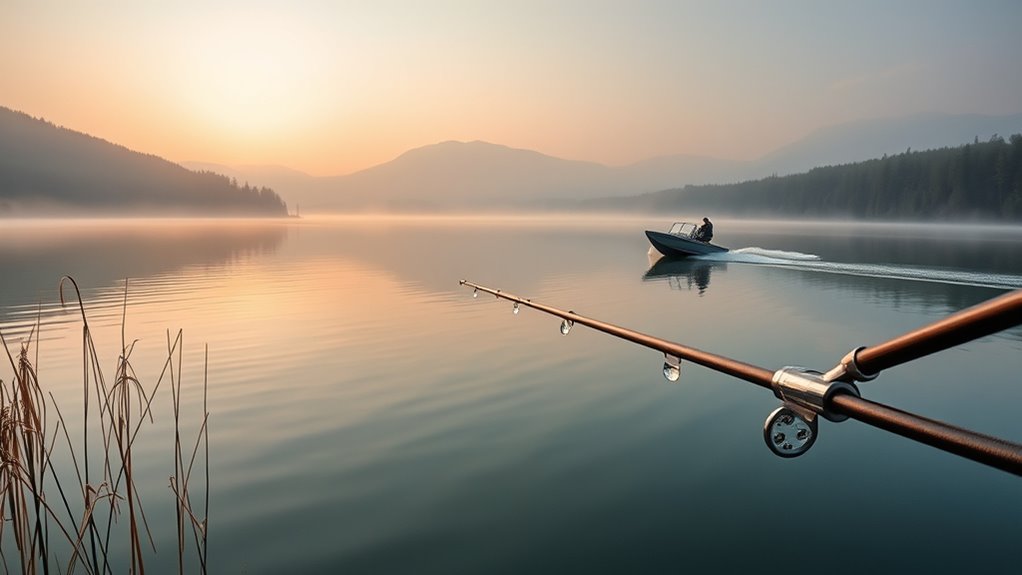
If you want a change of pace from Bantam’s rocky shallows, head north to Lake Memphremagog, a cross-border gem straddling Vermont and Quebec where both smallmouth and largemouth thrive. You’ll find the Lake Memphremregog fishery offers diverse targets — smallmouth bass, largemouth bass, landlocked salmon and trout — all framed by scenic shores and nearby villages that make trips feel effortless. Fish here when you’re chasing trophy bass; deep structure and clear coves produce big specimens. Remember this is true cross-border fishing: seasons, licensing and catch rules differ between Vermont and Quebec, so check bass regulations and cross-border regulations before you launch. Respect limits and reporting requirements, and you’ll enjoy one of New England’s standout bass destinations. The lake’s varied underwater structure also supports a diverse fishing experience, making it productive for anglers of all skill levels.
Final Thoughts
You’ve got a solid list of New England bass destinations to chase—each lake offers its own mix of species, structure and seasonal opportunity. Whether you’re trolling Champlain for smallies, pitching to Quabbin’s largemouths, or working Sebago’s rocky points, plan around water temperature, cover and forage. Pack gear for both finesse and power presentations, watch local regs, and be ready to adapt your tactics as conditions change—you’ll put more fish in the boat and make better memories.

